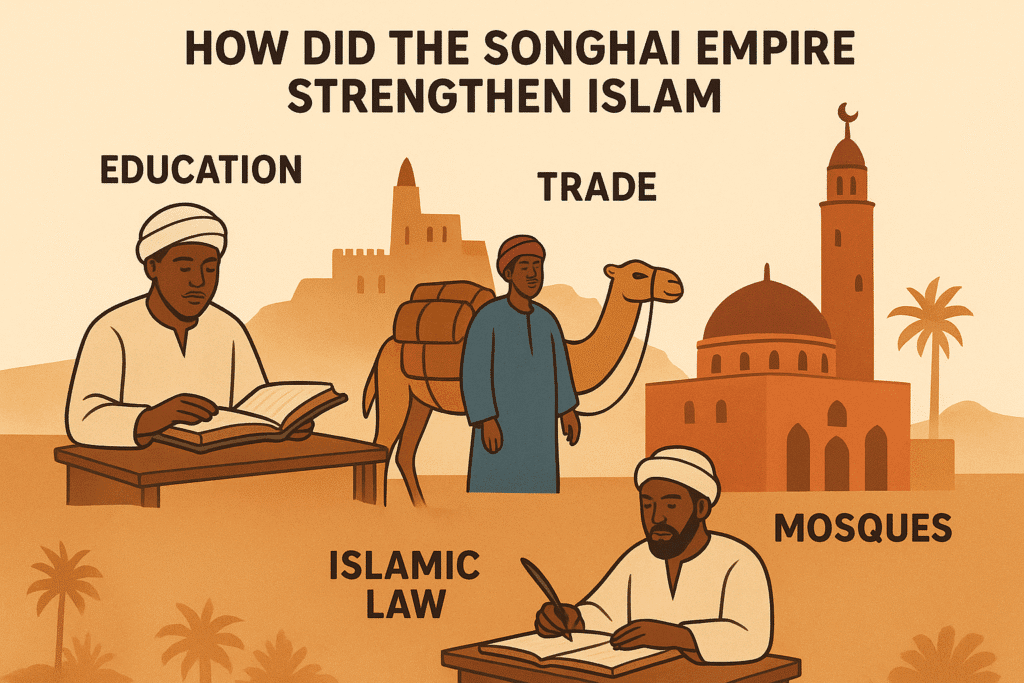How Did the Songhai Empire Strengthen Islam in West Africa?
Once a mighty force in West Africa, the Songhai Empire left a huge mark on the growth and strength of Islam in the region. Its story is one of powerful rulers, thriving cities, and a society brought together by new beliefs. Understanding the Songhai Empire’s impact on Islam reveals how religion shaped culture, education, and trade for generations.

The Rise of the Songhai Empire and Early Islam
After the fall of the Mali Empire, the Songhai stepped in as the leading power in West Africa. By the 15th century, Songhai controlled key trade cities along the Niger River. Islam had already arrived with North African merchants and scholars, but it was not yet woven into every part of life.
As the Songhai Empire grew, it blended old traditions with Islamic ideas. Leaders saw Islam as a way to unite their people and connect with distant markets. The empire quickly became home to both African heritage and Muslim faith, building a unique society along the Sahara’s southern edge. You can find more background on the Songhai’s rise at Songhai Empire.
Government Support for Islamic Institutions
Songhai rulers did not leave religion to chance. They supported Islam through policies and by setting examples for their subjects. Some leaders even visited Mecca or invited famous scholars to their courts.
Askia Muhammad stands out as the ruler who truly shaped Songhai into an Islamic state. His reign started in 1493, marking a big push for Islamic law and culture across the empire. He set up systems that blended African leadership with Islamic values, building trust both at home and with Muslim traders abroad. Learn more about Songhai rulers and their government at Britannica’s page on the Songhai Empire.
Promoting Islamic Law and Education
Askia Muhammad and other rulers encouraged learning and justice rooted in Islam. They supported courts based on Sharia (Islamic law) and funded schools to teach the Quran, law, and language. Timbuktu, already known as a hub for traders and travelers, became one of the most famous schools of Islam anywhere in the world. The empire kept attracting teachers and thinkers, making cities like Timbuktu symbols of knowledge and faith.
Building Mosques and Religious Centers
Songhai leaders built impressive mosques throughout their empire. These were not just places to pray, but centers for teaching and community life. Cities like Timbuktu, Gao, and Jenne became gathering spots for students, traders, and religious leaders. The history of Timbuktu shows how Songhai construction and support turned the city into an intellectual capital.
Cultural and Economic Impact of Islam under Songhai Rule
Islam’s arrival touched every part of daily life in Songhai. Muslim customs influenced how people dressed, spoke, and traded with others. Rulers encouraged everyone to learn Arabic and follow Muslim holidays and practices.
Trade with North Africa and the Middle East grew as the empire deepened its Islamic identity. Gold, salt, and ideas flowed across borders, proudly showing off Songhai’s place in the Muslim world.
Encouraging Scholarship and Trade with Other Muslim Lands
The Songhai Empire became a magnet for scholars. Leaders built libraries and supported teachers, turning cities into rivals of famous centers in Egypt and Morocco. The movement of traders and scholars meant that Songhai was never isolated. Partnerships with other Muslim cities shaped the empire’s growth, its laws, and the daily rhythm of life.
Conclusion
The Songhai Empire helped Islam go from a faith of merchants and travelers to the very fabric of West African society. By supporting Islamic law, founding famous schools, building mosques, and linking their people with the Muslim world, Songhai leaders made Islam a lasting part of the region’s history. These changes still shape West African culture and connect it to the wider Islamic story today. For a thorough look at the Songhai’s legacy, see Fall of the Songhai Empire. Read More

